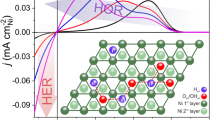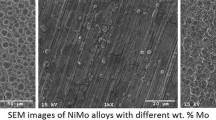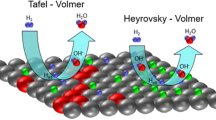Abstract
A microcalorimetric method has been used to investigate the self-discharge behaviour of nickel oxyhydroxide electrodes in a pressurized gaseous hydrogen environment. It was found that the heat generation rate is proportional to hydrogen pressure, and is significantly dependent on the immersion state of the electrode in the electrolyte. Hence, diffusion of dissolved hydrogen gas towards or within the electrode controls, at least partially, the self-discharge rate. However, the heat generation decreases exponentially with time, indicating that self-discharge is also proportional to the amount of the charged active material available for the reaction. The presence of Mg, Co and Cd oxides or hydroxides appears to inhibit self-discharge. It was found that direct chemical reaction between dissolved hydrogen and the active material dominates, while in addition, electrochemical oxidation of hydrogen coupled with electrochemical reduction of the active material might also occur at a much smaller rate than the direct reaction.
Similar content being viewed by others
References
Y. Kim, A. Visintin, S. Srinivasan and A. J. Appleby, in ‘Nickel Hydroxide Electrodes’, (edited by D. A. Corrigan and A. H. Zimmerman),The Electrochemical Society, Pennington NJ,90-4 (1990), p. 368.
A. Visintin, S. Srinivasan, A. J. Appleby and H. S. Lim, in pressJ. Electrochem. Soc.
H. S. Lim and D. B. Losee, ‘Studies on Self-Discharge Mechanism of Ni−H2 Cells', to be published.
L. D. Hansen and R. M. Hart,J. Electrochem. Soc. 125 (1978) 842.
L. D. Hansen and H. Frank,134 (1987) 1.
D. F. Picketet al., Proceedings of the 15th Intersociety Energy Conversion Engineering Conference, Seattle WA (1980) p. 1918.
B. I. Tsenter and A. I. Sluzhenvskii,Z. Prikladnoi Khim. 54 (1981) 2545.
G. Holleck, Proceedings of the 1977 Goddard Space Flight Battery Workshop, NASA Conference Publication (1977) p. 2041.
R. Battio and E. Wilhelm, ‘IUPAC Solubility Data Series’, (edited by C. L. Young), Pergamon Press, New York,5/6 (1981) p. 33.
‘Chemical Engineering Handbook’, 5th ed., (edited by R. H. Perry and C. H. Chilton), McGraw Hill, New York (1973), pp. 3–23.
G. W. D. Briggs and P. R. Snodin,Electrochim. Acta 27 (1982) 565.
D. M. MacArthur,J. Electrochem. Soc. 117 (1970) 729.
Z. Mao and R. E. White,J. Electrochem Soc. 138 (1991) 3354.
S. G. Bratsh,J. Phys. Chem. Data 18 (1989) 1.
C. Zhang, R. E. White, J. Kim, A. J. Appleby and S. Srinivasan, in Y. Kim et al., ‘Nickel Hydroxide Electrodes’ (edited by D. A. Corrigan and A. H. Zimmerman),The Electrochemical Society, Pennington NJ,90-4 (1990) p. 356.
Author information
Authors and Affiliations
Rights and permissions
About this article
Cite this article
Mao, Z., Visintin, A., Srinivasan, S. et al. Microcalorimetric study of the self-discharge of the NiOOH/Ni(OH)2 electrode in a hydrogen environment. J Appl Electrochem 22, 409–414 (1992). https://doi.org/10.1007/BF01077541
Received:
Revised:
Issue Date:
DOI: https://doi.org/10.1007/BF01077541




